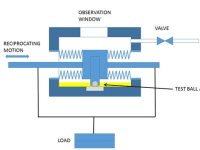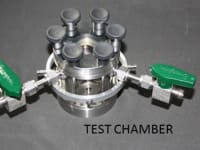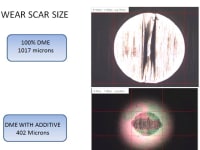Although more efficient than petrol vehicles, diesels produce relatively high levels of nitrogen dioxide (NO2) and soot. Recent health concerns about particulate matter have given diesels a less environmentally-friendly image:
http://www.bbc.co.uk/news/science-environment-30381223
LPG (liquefied natural gas) is currently used as an alternative to petrol. Now, an equivalent alternative to diesel fuel has been developed, Dimethylether (DME). Like LPG it is a gas at atmospheric pressures, requiring storage at relatively moderate pressures of approximately 4 bar (60psi). This article describes the development of a new test device able to measure the properties of a promising new type of fuel.
DME is a synthetically produced gas, primarily used as an aerosol propellant. One new application for DME which is under development in a number of countries is as a direct alternative to diesel fuel. It's low ignition temperature and high cetane number (its ability to ignite) make it an ideal replacement fuel. An existing diesel engine can run with DME, only the fuel tank and supply system will need to be changed to contain the liquid fuel at a relatively low pressure of d 6 bar (about the same as a cycle tire).
Since there are no carbon-carbon double bonds, the DME combustion process produces virtually no soot (particulate matter) or nitrogen oxides (NOx), the bane of any Diesel engine. In current Diesel engines, the fuel itself acts as a lubricant, protecting the fuel injector and other system components from excessive wear. Diesel fuel lubricity additives are required and standard tests have been developed to determine a fuel’s "lubricity", or its wear protection ability. The standard tests involve reciprocating a loaded ball and disc immersed in the fluid for a specified period of time. At the end of the test a wear scar is measured. The lower the wear scar, the better the fuels lubricity.
One of the main limitations of DME is that it has naturally very low lubricity, producing unacceptably high level of wear. Since it is a gas at room temperature, the fuel must be pressurized to make it a liquid, complicating both the handling and testing of such fuel. Test apparatus has been developed which greatly simplifies this testing under pressure. Rather than pressurize a complete test rig, a small fuel cell (70mm diameter) contains the liquid and the reciprocating motion applied through some double acting bellows. This makes sealing the device very simple and completely maintenance free. The fuel cell to be easily retrofitted to existing test equipment, greatly reducing cost.
The figures below show the test rig fuel cell and a schematic cross section. Tests show that the wear scar of pure DME is very high, but can be significantly reduced with the use of appropriate additives.
Like this entry?
-
About the Entrant
- Name:Matthew Smeeth
- Type of entry:teamTeam members:Matthew Smeeth
Clive Hamer - Software used for this entry:Autocad
- Patent status:none








